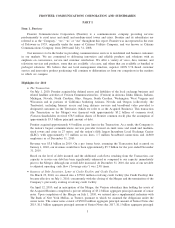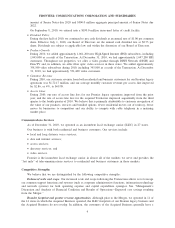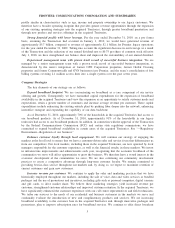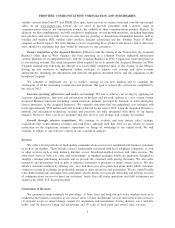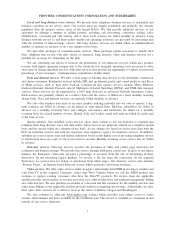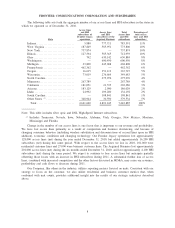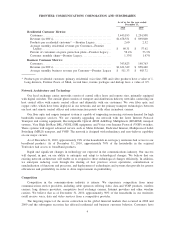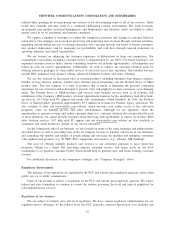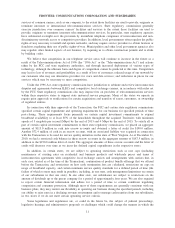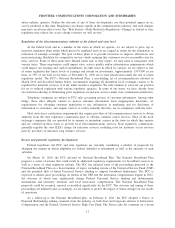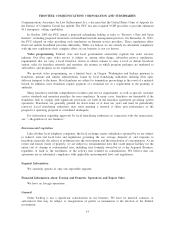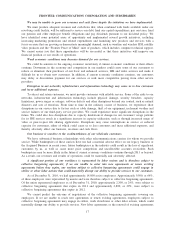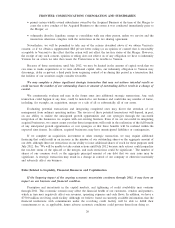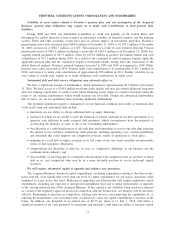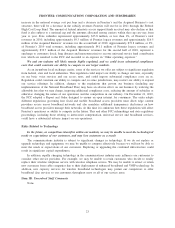Frontier Communications 2010 Annual Report Download - page 14
Download and view the complete annual report
Please find page 14 of the 2010 Frontier Communications annual report below. You can navigate through the pages in the report by either clicking on the pages listed below, or by using the keyword search tool below to find specific information within the annual report.range of possible outcomes and Frontier cannot predict whether or when the FCC will take additional actions or
the effect of any such actions on the Company’s subsidy revenues.
The FCC also has an ongoing proceeding considering whether to make changes in its regulatory regime
governing special access services, including whether to mandate lower rates, change standards for deregulation
and pricing flexibility, or to require changes to other terms and conditions. When and how these proposed
changes will be addressed are unknown and, accordingly, we are unable to predict the impact of future changes
on our results of operations. However, future reductions in our subsidy and access revenues will directly affect
our profitability and cash flows as those regulatory revenues do not have the same level of associated variable
expenses. Our access and subsidy revenues declined in 2010 compared to 2009 and are both likely to decline
further in 2011.
Certain states also have their own open proceedings to address reform to intrastate access charges and
other intercarrier compensation. In addition, we have been approached by, and/or are involved in formal state
proceedings with, various carriers seeking reductions in intrastate access rates in certain states. We cannot
predict when or how these matters will be decided or the effect on our subsidy or switched access revenues.
However, future reductions in our subsidy or switched access revenues will directly affect our profitability and
cash flows as those regulatory revenues do not have an equal level of associated variable expenses.
Regulators at both the federal and state levels continue to address whether VOIP services are subject to the
same or different regulatory and intercarrier compensation regimes as traditional voice telephony. The FCC has
concluded that certain VOIP services are jurisdictionally interstate in nature and states therefore are preempted
from regulating the rates, terms and conditions on which providers offer these services. The FCC has not
addressed other related issues, such as: whether or under what terms VOIP originated traffic may be subject to
intercarrier compensation; and whether VOIP services are subject to general state requirements relating to
taxation and general commercial business requirements. The FCC has stated its intent to address these open
questions in subsequent orders in its ongoing “IP-Enabled Services Proceeding.” Internet telephony may have
an advantage in the marketplace over our traditional services if it remains less regulated.
Some state regulators have in the past considered imposing on regulated companies (including us) cash
management practices that could limit the ability of a company to transfer cash among its subsidiaries or to its
parent company. None of the existing state requirements materially affect our cash management, but future
changes by state regulators could affect our ability to freely transfer cash within our consolidated companies.
Current and potential Internet regulatory obligations
In connection with our Internet access offerings, we could become subject to laws and regulations as they
are adopted or applied to the Internet. There is currently only limited regulation applicable to these services. As
the significance of the Internet expands, federal, state and local governments may adopt rules and regulations,
or apply existing laws and regulations to the Internet (including Internet access services), and related matters
are under consideration in both federal and state legislative and regulatory bodies. We cannot predict whether
the outcome of pending or future proceedings will prove beneficial or detrimental to our competitive position.
The FCC adopted orders which put wireline broadband Internet access service, commonly delivered by
DSL or fiber technology, as well as mobile wireless based broadband Internet access service and other forms of
broadband Internet access services on an equal regulatory footing with cable modem service. This approach is
consistent with a United States Supreme Court decision upholding the FCC’s classification of cable modem
services as “information services” not subject to mandatory common carriage regulation. Specifically, the FCC
has determined that these information services are functionally integrated with any underlying telecommunica-
tions component, and that there is no obligation to separate out and offer that transmission component subject
to common carriage regulation. The FCC provides the option, however, for rate of return carriers to voluntarily
provide wireline broadband Internet access service as a common-carrier offering. In the National Broadband
Plan, the FCC staff team indicates that the FCC will consider the legal classification of broadband as it reviews
the Plan.
The FCC has imposed particular regulatory obligations on broadband services. For example, it has
concluded that VOIP and facilities-based broadband Internet access providers must comply with the
13
FRONTIER COMMUNICATIONS CORPORATION AND SUBSIDIARIES


